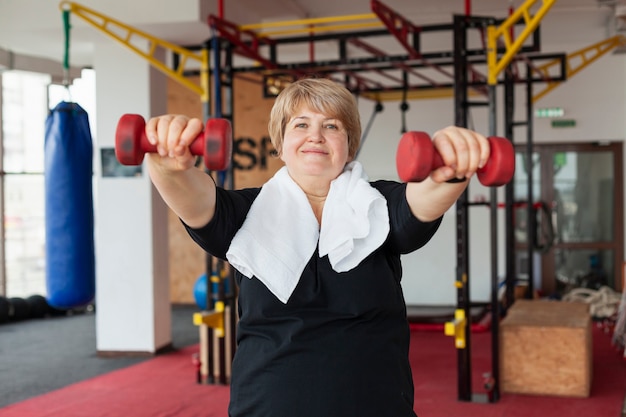Strength Training: Reduce Fall Risk by 40% After 65

Strength training can significantly reduce the risk of falls by 40% in individuals over 65 by improving muscle strength, balance, and coordination, leading to greater stability and confidence in movement.
Wondering how to stay steady on your feet as you age? The answer might be simpler than you think: strength training can reduce your risk of falls by 40% after age 65, helping you maintain independence and an active lifestyle.
The Alarming Reality of Falls in Older Adults
Falls are a significant health concern for older adults, often leading to serious injuries and a decreased quality of life. Understanding the prevalence and impact of falls is the first step in addressing this issue and exploring effective prevention strategies.
Why Falls Are a Major Concern
Falls aren’t just minor slips; they can result in fractures, head injuries, and even death. The fear of falling can also lead to reduced physical activity, isolation, and further decline in health.
- Falls are a leading cause of injury and death from injury among older Americans.
- Each year, millions of older adults fall, and many suffer moderate to severe injuries.
- The financial burden of fall-related injuries is substantial, costing billions of dollars annually.

Beyond the physical injuries, falls can also have a profound psychological impact. Many older adults develop a fear of falling, which can lead to decreased mobility and social isolation. This fear can create a cycle of inactivity and increased fall risk, further diminishing their overall well-being.
How Strength Training Fortifies Your Body Against Falls
Strength training, also known as resistance training, involves using weights, resistance bands, or your own body weight to build muscle strength and endurance. This type of exercise can have a remarkable impact on reducing your risk of falls.
Building a Stronger Foundation
Strength training helps improve muscle strength, which is essential for maintaining stability and balance. Stronger muscles provide better support for your joints and help you react quickly to avoid a fall.
Engaging in regular strength training exercises can enhance your balance and coordination. These improvements enable you to maintain your equilibrium and navigate uneven surfaces with greater confidence.
- Strengthens leg muscles, improving balance and stability.
- Enhances core strength, providing better support for your spine and improving posture.
- Increases reaction time, allowing you to respond quickly to potential hazards.
The Science Behind the 40% Reduction
The claim that strength training can reduce your risk of falls by 40% is supported by numerous scientific studies. These studies have demonstrated a clear link between strength training and improved balance, stability, and overall fall prevention.
One meta-analysis, which combined the results of multiple studies, found that older adults who participated in strength training programs experienced a significant reduction in their risk of falls compared to those who did not. The studies considered a variety of strength programs using free weights, machines and resistance bands.
Key Findings from Research
Several studies have highlighted the specific benefits of strength training for fall prevention. For example, a study published in the Journal of the American Geriatrics Society found that a 12-week strength training program improved balance and reduced the risk of falls by 37% in older adults.
- Studies consistently show that strength training improves balance and gait.
- Strength training increases muscle mass and strength, which are crucial for preventing falls.
- Research indicates that strength training can improve bone density, reducing the risk of fractures if a fall does occur.

It’s important to note that the effectiveness of strength training for fall prevention depends on several factors, including the intensity and duration of the training program, as well as the individual’s overall health and fitness level. Consulting with a healthcare professional or certified trainer is recommended to develop a safe and effective strength training plan.
Getting Started with Strength Training After 65
Starting a strength training program after 65 may feel intimidating, but it’s entirely achievable with the right approach. Begin slowly and gradually increase the intensity and duration of your workouts as you get stronger.
Simple Exercises to Begin With
Start with bodyweight exercises like squats, lunges, and push-ups against a wall. As you get stronger, you can add weights or resistance bands to increase the challenge.
Leg exercises such as squats and calf raises are particularly important for fall prevention. These exercises strengthen the muscles in your legs and improve your balance.
- Chair squats: Stand up and sit down from a chair repeatedly.
- Wall push-ups: Perform push-ups against a wall to build upper body strength.
- Calf raises: Stand on your toes and lower back down to strengthen your calf muscles.
Designing a Safe and Effective Strength Training Program
When designing a strength training program for older adults, safety should be your top priority. Always warm up before each workout and cool down afterward. Use proper form to avoid injuries and listen to your body.
Key Considerations for Safety
It’s essential to consult with your doctor before starting any new exercise program, especially if you have underlying health conditions. A physical therapist or certified personal trainer can help you design a safe and effective strength training program tailored to your needs and abilities.
Proper form is crucial during strength training to prevent injuries. If you’re unsure about the correct technique, seek guidance from a qualified professional.
- Consult with your doctor before starting any new exercise program.
- Work with a qualified trainer to learn proper form and technique.
- Start with lighter weights or resistance and gradually increase the intensity.
Beyond Strength: A Holistic Approach to Fall Prevention
While strength training is a powerful tool for fall prevention, it’s most effective when combined with other strategies. A holistic approach to fall prevention includes addressing environmental hazards, managing medical conditions, and incorporating balance exercises into your routine.
Creating a Safe Environment
Make sure your home is well-lit and free of clutter. Remove tripping hazards such as loose rugs and cords. Install grab bars in the bathroom and use non-slip mats in the shower.
Managing underlying medical conditions, such as vision problems, diabetes, and arthritis, can also help reduce your risk of falls. Regular check-ups and appropriate medical care are essential.
- Ensure adequate lighting in your home.
- Remove tripping hazards like loose rugs and cords.
- Install grab bars in bathrooms and use non-slip mats in showers.
Maintaining Independence and Quality of Life
Preventing falls is not just about avoiding injuries; it’s about maintaining your independence and quality of life as you age. By incorporating strength training and other fall prevention strategies into your routine, you can stay active, engaged, and enjoy a fulfilling life.
Strength training can help you maintain your physical function and mobility, allowing you to continue doing the things you love. Whether it’s gardening, traveling, or spending time with family and friends, staying strong and steady on your feet can enhance your overall well-being.
| Key Point | Brief Description |
|---|---|
| 💪 Muscle Strength | Strength training increases muscle strength, improving stability. |
| 🤸 Balance Improvement | Strength exercises enhance balance and coordination. |
| 🏡 Home Safety | Ensure a well-lit, clutter-free home environment. |
| 🩺 Medical Check-ups | Manage medical conditions to reduce fall risk. |
FAQ
▼
Aim for at least two days a week, focusing on major muscle groups. Consistency is key for building and maintaining strength over time, reducing your risk of falls.
▼
Chair squats, wall push-ups, and calf raises are excellent starting points. These exercises target key muscles and can be easily modified to fit your fitness level for fall prevention.
▼
Yes, but it’s crucial to consult your doctor and work with a qualified trainer. They can design a program that accommodates your condition and minimizes joint stress, preventing falls.
▼
Many people notice improvements in strength and balance within a few weeks of consistent training. Stay patient and persistent, and your efforts will pay off in fall prevention.
▼
Home safety, medical check-ups, and balance exercises are crucial. Addressing these factors alongside strength training provides a comprehensive approach to fall prevention and improved well-being.
Conclusion
Incorporating strength training into your routine after age 65 can significantly reduce your risk of falls, helping you maintain your independence and quality of life. Embrace this holistic approach to healthy aging and enjoy the benefits of a stronger, more stable you.
